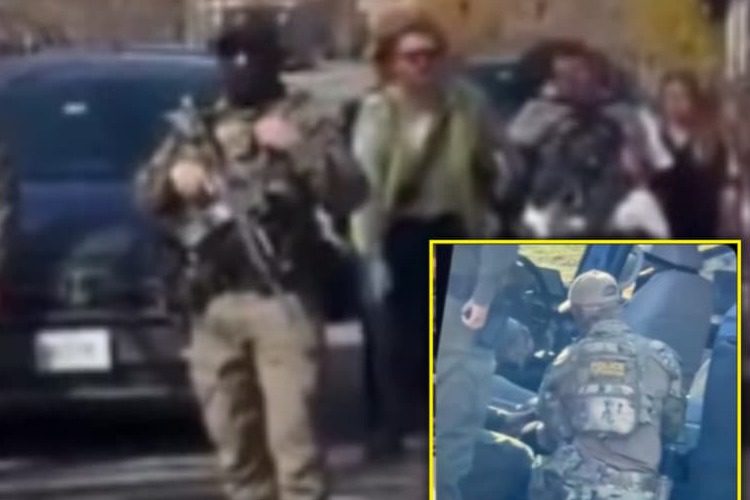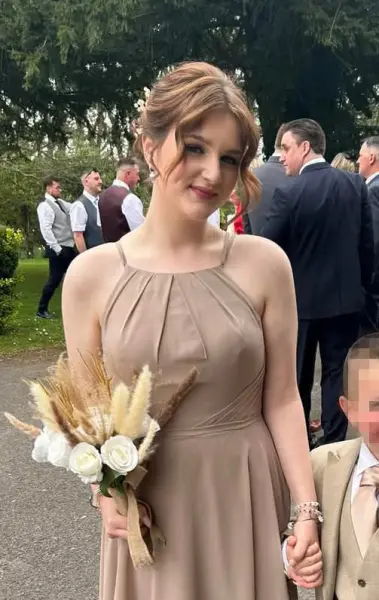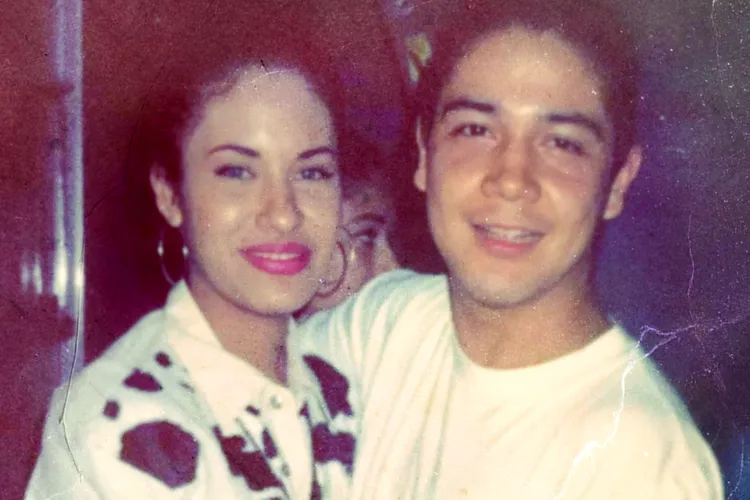Protester Shot During Fiery Clash with Federal Agents – As Trump’s Deportation Blitz Ignites Sanctuary City Showdown
The autumn leaves swirled like confetti in chaos on the quiet streets of east Charlotte’s working-class enclaves, where the first light of November 16, 2025, brought not the gentle hum of Sunday brunch but the staccato bark of federal agents’ commands echoing off shotgun houses and chain-link fences. It was supposed to be a routine worship service at Our Lady of the Assumption Catholic Church on Milton Road, a modest brick sanctuary that’s served the neighborhood’s Hispanic community for decades—a place of solace for families who’d crossed borders in search of something better, only to find themselves in the crosshairs of President Donald J. Trump’s unyielding deportation machine. But as parishioners gathered for 8 a.m. Mass, the air thickened with tension: unmarked vans screeching to a halt, black-clad ICE agents spilling out in tactical gear, their vests emblazoned with “POLICE” in bold yellow, rifles slung low but ready. What unfolded next was a scene ripped from a nightmare—a frantic scramble as congregants bolted into the surrounding woods, children crying in their mothers’ arms, and then, amid the shouts and shoves, the crack of gunfire that sent shockwaves through the Queen City and beyond. Videos circulating on X captured the harrowing moment: a Hispanic man, identified by witnesses as 34-year-old Carlos Mendoza, crumpling to the ground after an ICE agent fired a single shot, his body slumping against a squad car as protesters surged forward, blocking vans and screaming “No more!” For Mendoza’s family, huddled in prayer inside the church, it was devastation; for Trump loyalists watching from living rooms across America, vindication—a stark reminder that sanctuary policies have a price, and on this Sunday morning, someone paid it.

Tamara Ruiz, Mendoza’s 29-year-old sister, had just lit a candle for her nephew’s communion when the doors burst open, agents barking orders in English and Spanish, demanding papers from the altar boys and yard workers trimming poinsettias for the holiday season. “They came like ghosts—masks, guns, no warning,” Tamara recounts later, her voice trembling over a crackling phone line from the hospital waiting room where Carlos clings to life, a bullet grazing his shoulder in what ICE calls a “defensive discharge” after he allegedly lunged at an agent during the melee. Tamara, a U.S. citizen born in Charlotte to Guatemalan parents, works double shifts at a local bakery to send money home, her American Dream stitched from remittances and resilience. “Carlos was no criminal—he mows lawns, coaches soccer, prays every Sunday. He came legally 10 years ago, but papers got lost in the backlog. Now this? Because he stood up for his friends?” Her words, raw and resonant, capture the heartbreak rippling through Charlotte’s immigrant enclaves, where 14 percent of the population hails from abroad, per Census data, and churches like Our Lady serve as lifelines—food pantries by day, sanctuaries by night. For Tamara, the shooting isn’t abstract; it’s the shattering of faith in a system she thought protected the faithful, a federal force storming sacred ground in a city that’s prided itself on “welcoming” since the 2017 sanctuary ordinance under Mayor Vi Lyles.
The raids themselves were the opening act in a weekend of high-stakes theater, part of “Operation Charlotte’s Web,” Trump’s administration’s audacious bid to dismantle Democratic strongholds one arrest at a time. Launched at dawn on November 15, the sweep saw 200 ICE agents, bolstered by Border Patrol tactical units and even FBI gang task force embeds, fan out across 25 locations—from NoDa’s hipster lofts to West Boulevard’s weary apartments—snaring 81 individuals by Sunday night, per U.S. Customs and Border Protection tallies. Targets weren’t random dreamers; they were the “worst of the worst,” Acting ICE Director Thomas Homan thundered in a midday briefing from the federal courthouse downtown: MS-13 shot-callers with machete assaults on their rap sheets, Venezuelan Tren de Aragua enforcers slinging fentanyl that’s felled 1,500 Mecklenburg lives since 2022, and Salvadoran nationals with rape convictions who’d gamed asylum claims into years of freedom. “These aren’t families at Mass—they’re fugitives from justice, hiding in plain sight because sanctuary lunacy lets them,” Homan said, his gravelly Georgia drawl cutting through the press scrum like a warrant served. Videos from the operations—agents rappelling balconies, zip-tying suspects in driveways under autumn oaks—painted a picture of precision amid pandemonium, with local CMPD officers relegated to traffic control after Lyles’ 2021 ordinance barred cooperation on civil immigration matters.

Protests ignited like dry tinder, organized by a coalition of DSA chapters, immigrant rights groups like the Carolina Migrant Network, and even local clergy who’d decried the sweeps from pulpits that morning. By 9 a.m. at Our Lady, 200 demonstrators—many in fluorescent vests, chanting “Families not raids!”—formed human chains around vans, blocking avenues and turning Milton Road into a standoff straight out of Ferguson. “Coordinated chaos,” one ICE source leaked to Fox News, describing how spotters on bikes relayed agent movements via group chats, a tactic honed in sanctuary cities from Seattle to San Francisco. The flashpoint came at 9:52 a.m., captured in grainy cell footage that’s amassed 4.2 million views on X: agents advancing on a group of men raking leaves near the church hall, protesters surging to intervene, and then Mendoza—described by witnesses as a “peaceful protester” grabbing a agent’s vest—lunging forward. The shot rang out, a .40-caliber round from a sidearm, grazing his arm and embedding in a squad car door, per Mecklenburg EMS reports. Chaos ensued: screams piercing the air, a woman collapsing in prayer, agents forming a perimeter as backup roared in. Mendoza, bleeding but conscious, was rushed to Atrium Health Carolinas Medical Center, his condition upgraded to stable by evening—outpatient surgery for the wound, no internal damage, a miracle amid the mayhem.
For the agents on the line—many with families back in Virginia or Texas, hearts pounding under Kevlar as they faced a phalanx of fists and flags—it was a split-second call in a powder keg primed by politics. “They threw everything—bottles, barricades, bodies,” recounted one veteran agent, speaking anonymously to the Daily Mail, his hands still shaking from the adrenaline dump. “The guy’s charging, we’ve got a team pinned, and the shot’s to stop, not kill. Trump’s got our backs—no more hands-off in these hellholes.” The administration’s line, echoed by White House Press Secretary Karoline Leavitt in a 2 p.m. briefing, frames it as “necessary force against violent obstruction,” citing 18 U.S. Code § 111 on assaulting federal officers, with three protesters arrested for “interfering with enforcement.” Homan, in a Fox & Friends hit that morning, didn’t mince: “Sanctuary cities breed this—demagogues like Lyles inviting lawlessness, and now blood on the leaves. Trump’s ending it, one raid at a time.” By nightfall, the toll stood at 92 arrests total, with raids spilling into Sunday’s suburbs, agents hauling duffels from dawn detentions as protesters lit candles at Our Lady, their vigils a haunting counterpoint to the handcuff clicks.
Charlotte’s mayor, Vi Lyles—a trailblazing Black woman who’d steered the city through pandemic pinches and police reform reckonings—watched the horror unfold from city hall, her presser at 11 a.m. a masterclass in measured fury. “This is not who we are—armed federal troops terrorizing our churches, shooting our residents,” she said, voice cracking as she named Mendoza, a father of three with a green card pending since 2022. Lyles, whose 2023 reelection rode a wave of “equity” pledges, condemned the “militaristic optics” and vowed lawsuits against DHS for “civil rights violations,” citing the church as “private property” under Fourth Amendment shields. Her words resonated in the pews, where Father Miguel Torres, the parish priest who’d hidden families in the rectory during the raid, led a rosary for peace that afternoon, his homily a plea for “humanity over handcuffs.” For Lyles, it’s personal: Charlotte’s 15 percent immigrant population fuels its food trucks and construction crews, a vibrant vein in the city’s $200 billion economy. But critics, from Trump to local GOP firebrand Rep. Dan Bishop, counter with crime stats: Mecklenburg’s homicide rate up 22 percent since 2021, 40 percent tied to undocumented suspects per sheriff’s logs—a “sanctuary slaughter,” as Bishop thundered on Newsmax.
The shooting’s shadow stretched long into the evening, with X ablaze in a bipartisan blaze of outrage and analysis—conservatives hailing ICE as heroes “doing the job locals won’t,” liberals decrying a “police state prelude.” Videos looped endlessly: the agent’s draw in slow-mo, Mendoza’s stagger, protesters’ wails blending with sirens. Federal probes launched by noon—DOJ’s civil rights division and ICE’s Office of Professional Responsibility—promise transparency, but for Tamara Ruiz, waiting in that sterile ER lobby with rosary beads twisting in her fingers, answers can’t come soon enough. “Carlos was praying for peace—now he’s paying for politics,” she whispers, her brother’s blood a stain on the sanctuary steps that no mop can erase. As Trump’s deportation drive rolls on—1,200 removals nationwide that weekend, per DHS dashboards—Charlotte stands as a stark tableau: a city torn between compassion and crackdown, where one shot echoes the nation’s divided soul. For the agents who holstered trembling hands, the protesters who bandaged wounds, and the families who fled into the woods, this Sunday wasn’t worship—it was war, a heartbreaking harbinger of battles yet to come. In the Queen City’s fractured heart, where magnolias bloom amid the barricades, one truth lingers: when raids replace rosaries, redemption feels as distant as dawn.



